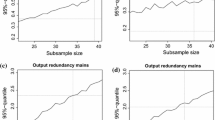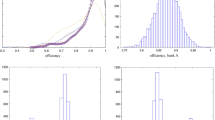Abstract
This article suggests a method for introducing a stochastic element into Farrell measures of technical efficiency as calculated via linear programming techniques. Specifically, a bootstrap of the original efficiency scores is performed to derive confidence intervals and a measure of bias for the scores. The bootstrap generates these measures of statistical precision for the “nonstochastic” efficiency measures by using computational power to derive empirical distributions for the efficiency measures.
Similar content being viewed by others
References
Aigner, D., C. A. K. Lovell, and P. Schmidt. (1977). “Formulation and Estimation of Stochastic Frontier Production Function Models.” Journal of Econometrics 6, 21-37.
Ali, A. I., and L. M. Seiford. (1993). “The Mathematical Programming Approach to Efficiency Analysis.” In H. O. Fried, C. A. K. Lovell, and S. S. Schmidt (eds.), The Measurement of Productive Efficiency: Techniques and Applications. New York: Oxford University Press.
Andersen, P., and N. C. Petersen. (1993). “A Procedure for Ranking Efficient Units in Data Envelopment Analysis.” Management Science 39, 1261-1264.
Cardani, A. M., M. Castagna, and M. Galeotti. (1991). “La Misurazione dell'Efficienza Economica: Al Settore Bancario Italiano.” Richerche Economiche 45, 57-77.
Charnes, A., W. W. Cooper, and E. Rhodes. (1978). “Measuring the Efficiency of Decision Making Units.” European Journal of Operations Research 2, 429-444.
Charnes, A., W. W. Cooper, and R. M. Thrall. (1991). “A Structure for Classifying and Characterizing Efficiencies and Inefficiencies in Data Envelopment Analysis.” Journal of Productivity Analysis 2, 197-237.
Davison, A. C., D. V. Hinkley, and E. Schechtman. (1986). “Efficient Bootstrap Simulation.” Biometrika 73, 555-566.
Efron, B. (1979). “Bootstrapping Methods: Another Look at the Jackknife.” Annals of Statistics 7, 1-26.
Efron, B., and R. J. Tibshirani. (1993). An Introduction to the Bootstrap. New York: Chapman and Hall.
Färe, R., S. Grosskopf, and C. A. K. Lovell. (1985). The Measurement of Efficiency and Production. Boston: Kluwer-Nijhoff Publishing.
Färe, R., S. Grosskopf, and C. A. K. Lovell. (1994). Production Frontiers. Cambridge, England: Cambridge University Press.
Farrell, M. J. (1957). “The Measurement of Productive Efficiency.” Journal of the Royal Statistical Society, Series A (General), 120(3), 253-281.
Lovell, C. A. K. (1993). “Production Frontiers and Productive Efficiency.” In H. O. Fried, C. A. K. Lovell, and S. S. Schmidt (eds.), The Measurement of Productive Efficiency: Techniques and Applications. New York: Oxford University Press.
Mammen, E. (1992). When Does Bootstrap Work?: Asymptotic Results and Simulations. New York: Springer-Verlag.
Meeusen, W., and J. van den Broeck. (1977). “Efficiency Estimation for Cobb-Douglas Production Functions with Composed Error.” International Economic Review 18, 435-444.
Mooney, C. Z., and R. D. Duval. (1993). Bootstrapping: A Nonparametric Approach to Statistical Inference. Newbury Park, CA: SAGE Publications, Inc.
Simar, L. (1992). “Estimating Efficiencies from Frontier Models with Panel Data: A Comparison of Parametric, Non-Parametric and Semi-Parametric Methods with Bootstrapping.” Journal of Productivity Analysis 3, 171-203.
Thompson, R. G., L. N. Langemeier, C.-T. Lee, E. Lee, and R. M. Thrall. (1990). “The Role of Multiplier Bounds in Efficiency Analysis with Application to Kansas Farming.” Journal of Econometrics 46, 93-108.
Timmer, C. P. (1971). “Using a Probabilistic Frontier Production Function to Measure Technical Efficiency.” Journal of Political Economy 79, 776-794.
Valdmanis, V. (1992). “Sensitivity Analysis for DEA Models: An Empirical Example Using Public vs. NFP Hospitals.” Journal of Public Economics 48, 185-205.
Author information
Authors and Affiliations
Rights and permissions
About this article
Cite this article
Ferrier, G.D., Hirschberg, J.G. Bootstrapping Confidence Intervals for Linear Programming Efficiency Scores: With an Illustration Using Italian Banking Data. Journal of Productivity Analysis 8, 19–33 (1997). https://doi.org/10.1023/A:1007768229846
Issue Date:
DOI: https://doi.org/10.1023/A:1007768229846




